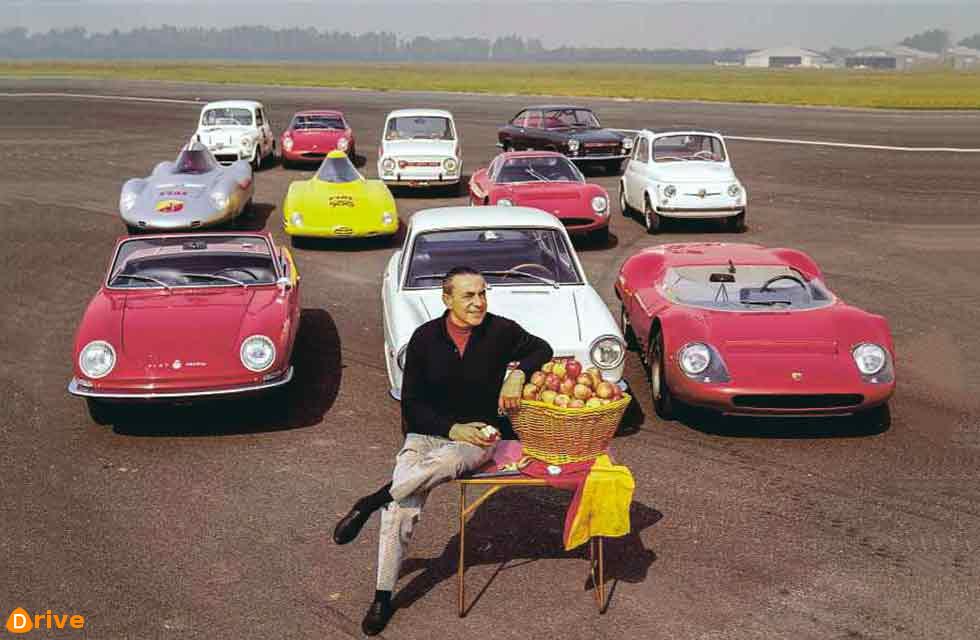Because of the miracles he worked with cars the size of teacups, they called him The Magician. Words Dale Drinnon.
We’re a small and rather perverse motoring sub-culture of a motoring sub-culture – we who lust after not just tiny, virtually unknown Italian cars, well outside the legacy mainstream, but best of all, the tiny, snotty, pumped-up cars who truly believe they’re mightier than the mighty. Cars with displacements measured in eye-droppers, attitudes worthy of entire F1 starting grids, and noises somewhere between atomic chainsaw and leopard in a burlap sack. And if you grew up in the golden post-war decades and dreamed of sending your Fiat out to humiliate Ferraris, your patron saint simply had to be Italian tuning genius Carlo Abarth.

Although he didn’t actually start life as Carlo Abarth. Or as Italian. Originally he was Karl Albert Abarth, and he was born Austrian, in Vienna, 1908. He first moved to Italy at 16 as a rising talent in motorcycle racing, on an apprenticeship with a bike company. But allowing for the travels and wanderings-about of a racing career, he would live there most of his life, and became ‘Carlo’ when he later also became a naturalised Italian.
He was a good rider, good enough to soon rate patronage from the Mussolini government (ergo the citizenship change), and was always heavily involved on the mechanical side, too. Carlo won multiple European championships with both bikes and sidehacks, frequently of his own design, before a heavy 1939 crash in a Yugoslavian event pretty well kicked his riding career in the teeth. He was in hospital there for almost a year and in convalescence longer. Then, basically stranded in Yugoslavia by World War Two, he hunkered down for the duration, recovering his health and running a small workshop, mostly converting local cars to kerosene.
With peacetime, though, and a return to Italy, Carlo’s fortunes took a life-changing turn. Through his connections with the Porsche family, he bagged a position in 1947 as sporting director on the legendary Cisitalia Grand Prix Car project, designed by Porsche for Cisitalia boss Piero Dusio, whose existing Fiat 500/1100-based cars were already a force in small-bore Italian motorsport. When the unfinished GP car bankrupted Dusio in 1948 and he split for Argentina, Abarth wound up with miscellaneous leftover cars and parts from those small-bore racers in lieu of overdue pay. This proved the genesis of his entire tiny-car empire. Carlo whipped those leftovers into shape as Cisitalia-Abarths, and in 1949 took them racing, with old biker friend Tazio Nuvolari among his drivers. Not only were they successful, and PR gold, the immortal Nuvolari took his final win, in his final race, driving a Cisitalia-Abarth. Abarth & Co subsequently established a healthy business in race-prep and the production and sale of speed parts, primarily Fiat, and aimed at the ordinary tinycar hot rodder. The company’s new scorpion badge logo, by the way, didn’t imply anything cool, like ‘small but deadly’; it was simply Carlo’s zodiac sign. Pity.
Over the next 20 years, Carlo did a booming trade, primarily with bolt-on performance equipment including cams and induction and exhaust systems shipped in complete-upgrade kits, and especially for the rear-engined Fiat 500/600/850 cars. ‘It is so much fun to humiliate bigger and more expensive cars,’ he reportedly often said, or variations thereof. Not that his stuff was cheap, mind; the full assortment for a 500 cost half the list-price of the receiving automobile. He also marketed exotic re-bodies – notably by Zagato – and turnover was good all around.
His exquisite team sports-racers, however, took wins galore, but without noticeable profit, and by the late ’60s Carlo was bizarrely plotting flashy, big-buck V12 campaigns for F1 and Le Mans. Proud, obstinate Carlo furthermore didn’t work and play well with unions, sponsors, partners, or anyone else for that matter. So in 1971, in an ironically similar overextended position to poor Cisitalia, Abarth & Co succumbed to a Fiat takeover. At a dinner on that evening, a friend recalled Carlo saying, overcome with tears: ‘I now have money, but no more am I the owner of my own name.’ He was sadly correct. World Rally Champion Fiat-Abarths were just around the corner but there was no role for The Magician; once he’d signed the contract, Fiat showed him the door and Carlo was done. He died a mere eight years later, back in Vienna, of stomach cancer. In another three weeks he would have been 71.
‘IF YOU DREAMED OF SENDING YOUR FIAT OUT TO HUMILIATE FERRARIS, YOUR PATRON SAINT SIMPLY HAD TO BE ITALIAN TUNING GENIUS CARLO ABARTH’





